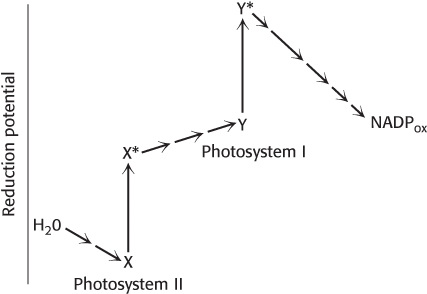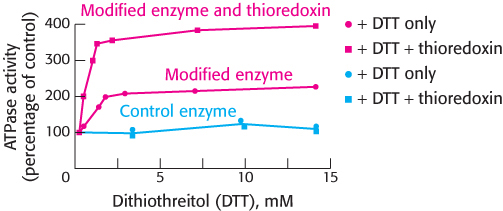PROBLEMS
Question 19.1
A crucial prereq. Human beings do not produce energy by photosynthesis, yet this process is critical to our survival. Explain.
Question 19.2
The accounting. What is the overall reaction for the light reactions of photosynthesis?
Question 19.3
Like a fife and drum. Match each term with its description.
|
(a) Light reactions ______ (b) Chloroplasts ______ (c) Reaction center ______ (d) Chlorophyll ______ (e) Light- (f) Photosystem I ______ (g) Photosystem II ______ (h) Cytochrome bf complex ______ (i) Water- (j) ATP synthase ______ |
1. Uses resonance energy transfer to reach the reaction center 2. Powers the formation of NADPH 3. Pumps protons 4. Site of photoinduced charge separation 5. Cellular location of photosynthesis 6. CF1–CF0 complex 7. Generates ATP, NADPH, and O2 8. Site of oxygen generation 9. Transfers electrons from H2O to P680 10. Primary photosynthetic pigment |
Question 19.4
A single wavelength. Photosynthesis can be measured by measuring the rate of oxygen production. When plants are exposed to light of wavelength 680 nm, more oxygen is evolved than if the plants are exposed to light of 700 nm. Explain.
Question 19.5
Combining wavelengths. If plants described in problem 4 are illuminated by a combination of light of 680 nm and 700 nm, the oxygen production exceeds that of either wavelength alone. Explain.
Question 19.6
Complementary powers. Photosystem I produces a powerful reductant, whereas photosystem II produces a powerful oxidant. Identify the reductant and oxidant and describe their roles.
Question 19.7
If a little is good. What is the advantage of having an extensive set of thylakoid membranes in the chloroplasts?
Question 19.8
Cooperation. Explain how light-
Question 19.9
One thing leads to another. What is the ultimate electron acceptor in photosynthesis? The ultimate electron donor? What powers the electron flow between the donor and the acceptor?
Question 19.10
Neutralization compensation. In chloroplasts, a greater pH gradient across the thylakoid membrane is required to power the synthesis of ATP than is required across the mitochondrial inner membrane. Explain this difference.
Question 19.11
Environmentally appropriate. Chlorophyll is a hydrophobic molecule. Why is this property crucial for the function of chlorophyll?
Question 19.12
Proton origins. What are the various sources of protons that contribute to the generation of a proton gradient in chloroplasts?
Question 19.13
Efficiency matters. What fraction of the energy of 700-
Question 19.14
That’s not right. Explain the defect or defects in the hypothetical scheme for the light reactions of photosynthesis depicted here.

Question 19.15
Electron transfer. Calculate the  and ΔG°′ for the reduction of NADP+ by ferredoxin. Use data given in Table 18.1.
and ΔG°′ for the reduction of NADP+ by ferredoxin. Use data given in Table 18.1.
Question 19.16
To boldly go. (a) It can be argued that, if life were to exist elsewhere in the universe, it would require some process like photosynthesis. Why is this argument reasonable? (b) If the starship Enterprise were to land on a distant planet and find no measurable oxygen in the atmosphere, could the crew conclude that photosynthesis is not taking place?
Question 19.17
Weed killer 1. Dichlorophenyldimethylurea (DCMU), a herbicide, interferes with photophosphorylation and O2 evolution. However, it does not block O2 evolution in the presence of an artificial electron acceptor such as ferricyanide. Propose a site for the inhibitory action of DCMU.
Question 19.18
Weed killer 2. Predict the effect of the herbicide dichlorophenyldimethylurea (DCMU) on a plant’s ability to perform cyclic photophosphorylation.
Question 19.19
Infrared harvest. Consider the relation between the energy of a photon and its wavelength.
588
Some bacteria are able to harvest 1000-
nm light. What is the energy (in kilojoules or kilocalories) of a mole (also called an einstein) of 1000- nm photons? What is the maximum increase in redox potential that can be induced by a 1000-
nm photon? What is the minimum number of 1000-
nm photons needed to form ATP from ADP and Pi? Assume a ΔG of 50 kJ mol−1 (12 kcal mol−1) for the phosphorylation reaction.
Question 19.20
Missing acceptors. Suppose that a bacterial reaction center containing only the special pair and the quinones has been prepared. Given the separation of 22 Å between the special pair and the closest quinone, estimate the rate of electron transfer between the excited special pair and this quinone.
Question 19.21
Close approach. Suppose that energy transfer between two chlorophyll a molecules separated by 10 Å takes place in 10 picoseconds. Suppose that this distance is increased to 20 Å with all other factors remaining the same. How long would energy transfer take?
Chapter Integration Problems
Question 19.22
Functional equivalents. What structural feature of mitochondria corresponds to the thylakoid membranes?
Question 19.23
Compare and contrast. Compare and contrast oxidative phosphorylation and photosynthesis.
Question 19.24
Energy accounts. In Section 20.1, the balance sheet for the cost of the photosynthetically powered synthesis of glucose is presented. Eighteen molecules of ATP are required. Yet, when glucose undergoes combustion in cellular respiration, 30 molecules of ATP are produced. Account for the difference.
Question 19.25
Looking for a place to rest. Albert Szent-
Mechanism Problem
Question 19.26
Hill reaction. In 1939, Robert Hill discovered that chloroplasts evolve O2 when they are illuminated in the presence of an artificial electron acceptor such as ferricyanide [Fe3+(CN)6]3−. Ferricyanide is reduced to ferrocyanide [Fe2+(CN)6]4− in this process. No NADPH or reduced plastocyanin is produced. Propose a mechanism for the Hill reaction.
Data Interpretation and Chapter Integration Problems
Question 19.27
The same, but different. The α3β3γ complex of mitochondrial or chloroplast ATP synthase functions as an ATPase in vitro. The chloroplast enzyme (both synthase and ATPase activity) is sensitive to redox control, whereas the mitochondrial enzyme is not. To determine where the enzymes differ, a segment of the mitochondrial γ subunit was removed and replaced with the equivalent segment from the chloroplast γ subunit. The ATPase activity of the modified enzyme was then measured as a function of redox conditions. Dithiothreitol (DTT) is a reducing agent.
What is the redox regulator of the chloroplast ATP synthase in vivo? The adjoining graph shows the ATPase activity of modified and control enzymes under various redox conditions.
 [Data from O. Bald et al. J. Biol. Chem. 275:12757–
[Data from O. Bald et al. J. Biol. Chem. 275:12757–12762, 2000.] What is the effect of increasing the reducing power of the reaction mixture for the control and the modified enzymes?
What is the effect of the addition of thioredoxin? How do these results differ from those in the presence of DTT alone? Suggest a possible explanation for the difference.
Did the researchers succeed in identifying the region of the γ subunit responsible for redox regulation?
What is the biological rationale of regulation by high concentrations of reducing agents?
What amino acids in the γ subunit are most likely affected by the reducing conditions?
What experiments might confirm your answer to part e?